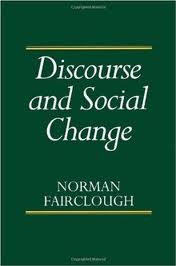Applied linguist, Norman Fairclough, use the term ‘discourse’ to make the connection between texts and their social purposes.

Applied linguist, Norman Fairclough, use the term ‘discourse’ to make the connection between texts and their social purposes.

On the other hand, ‘discourse’ is widely used in social theory and analysis, for example in the work of Michel Foucault, to refer to different ways of structuring areas of knowledge and social practice. Thus the discourse of ‘medical science’ is currently the dominant one in the practice of health care, though it contrasts with various wholistic ‘alternative’ discourses (e.g. those of homeopathy and acupuncture) as well as popular ‘folk’ discourses. Discourses in this sense are manifested in particular ways of using language and other symbolic forms such as visual images … . Discourses do not just reflect or represent social entities and relations, they construct or ‘constitute’ them; different discourses constitute key entities (be they ‘mental illness’, ‘citizenship’ or ‘literacy’) in different ways, and position people in different ways as social subjects (e.g. as doctors or patients), and it is these social effects of discourse that are focused upon in discourse analysis. Another important focus is upon historical change: how different discourses combine under particular social conditions to produce a new, complex discourse. A contemporary example is the social construction of the AIDS disease, in which various discourses (e.g. discourses of venereology, of cultural ‘invasion’ by ‘aliens’, of pollution) are combined to constitute a … discourse of AIDS. …
My attempt at drawing together language analysis and social theory centres upon a combination of this more social-theoretical sense of ‘discourse’ with the ‘text-and-interaction’ sense in linguistically-oriented discourse analysis. This concept of discourse and discourse analysis is three-dimensional. Any discursive ‘event’ (i.e. any instance of discourse) is seen as being simultaneously a piece of text, an instance of discursive practice, and an instance of social practice. The ‘text’ dimension attends to language analysis of texts. The ‘discursive practice’ dimension, like ‘interaction’ in the ‘text-and-interaction’ view of discourse, specifies the nature of the processes of text production and interpretation, for example which types of discourse (including ‘discourses’ in the more social-theoretical sense) are drawn upon and how they are combined. The ‘social practice’ dimension attends to issues of concern in social analysis such as the institutional and organizational circumstances of the discursive event and how that shapes the nature of the discursive practice, and the constitutive/ constructive effects of discourse referred to above.
I should add that ‘text’ is used [by me] in a sense which is quite familiar in linguistics but not elsewhere, to refer to any product whether written or spoken, so that the transcript of an interview or a conversation, for example, would be called a ‘text’. … [But] it is quite appropriate to extend the notion of discourse to cover other symbolic forces such as visual images, and texts which are combinations of words and images, for example in advertising. I shall use the term ‘discourse’ without an article to refer to language use seen in the above three-dimensional way (e.g. ‘the positioning of social subjects is achieved in discourse’), and I shall also refer to ‘discourse types’ which are drawn upon when people engage in discourse, meaning conventions such as genres and styles.
Fairclough, Norman, 1992. Discourse and Social Change. Cambridge: Polity Press. pp.3-4. || Amazon || WorldCat